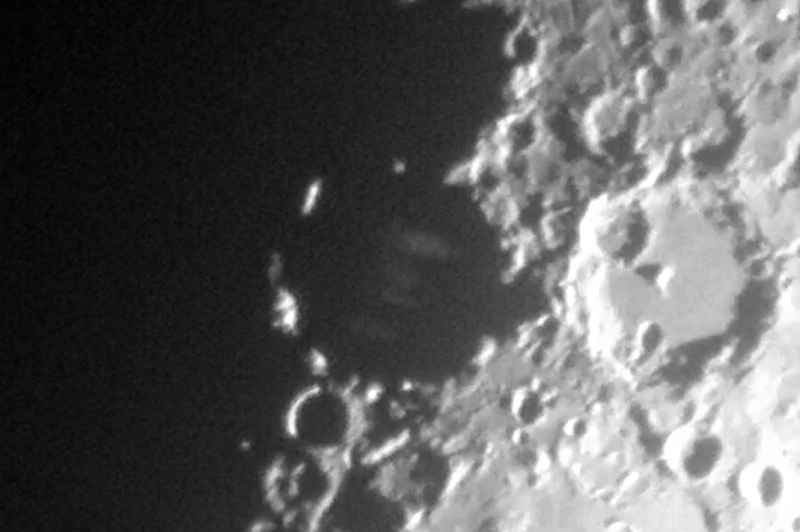
Lunar Craters Walther and Ptolemaeus, Critter Visitor
Posted: 14 August 2013
Monday, 12 August 2013, dawned partly cloudy, and the sky became more cloudy during the day and into the night. Cloudy skies continued on Tuesday, but the sky became partly cloudy by sunset. The observatory was opened at 1930 MST, 93°F. On my way to the observatory I took this photo of the western sky:

At 1938 MST, viewed Venus, 83X and 222X. Disk was still gibbous. Seeing not very good due to clouds. I then slewed to the nearly First Quarter moon and observed many nice shadows along the terminator at 222X. Took a quick look at Saturn, 222X, at 1950 MST, and then returned to the moon.
This image of Crater Walther is from one frame (cropped) of an iPhone 4 afocal video, 231X, MX-1 afocal adapter:

At 2010 MST, after taking a tour around the moon using 222X, I began monitoring the shadows in the Crater Walther. Seeing was not very good and there were still some clouds in the sky. At 2022 MST, I happened to look up from the eyepiece and saw the end of a very bright (brighter than Venus) non-Perseid meteor moving southeast below Sagittarius.
Beginning at 2027 MST, I began monitoring a shaft of sunlight crossing the dark floor of the Crater Ptolemaeus, which was also in the field of view of the Explore Scientific 9mm 100° eyepiece with Walther. At 2034 MST, I handheld the iPhone 4 over the 9mm eyepiece (222X) and took a short video. This is one (cropped) frame from the video showing the shaft of sunlight in Crater Ptolemaeus:

At 2036 MST, a second shaft of sunlight appeared on the crater floor. At 2039 MST, two more very faint shafts of sunlight appeared. At 2040 MST, the first shaft became wider and dramatically brighter. This frame from a handheld iPhone video shows two of the shafts easily and barely shows the two fainter shafts:

At 2046 MST, all four shafts were easily seen, with a 5th becoming faintly visible. At 2054 MST, the shafts began to widen, and at 2056 MST, the crater floor was becoming visible. At 2059 MST, the crater wall shadows on the crater floor were very well defined. At 2106 MST, did another handheld iPhone video, with this result:

It was really fascinating to watch sunrise on the floor of Crater Ptolemaeus.
At 2115 MST, a visitor came into the observatory:

By 2122 MST, the moon was too low in the sky for good viewing and some clouds were also interfering. At 2131 MST, saw a probable Perseid meteor near the moon. By 2135 MST, most of the floor of Crater Ptolemaeus was now illuminated. At 2200 MST, I escorted the Praying Mantis out of the observatory. Ended lunar observing at 2215 MST.
At 2219 MST, viewed M31 (Great Andromeda Galaxy), 83X, low in the eastern sky. I began waiting for moonset and for M74 galaxy to rise high enough for imaging. It appeared above the hill to the east at 2233 MST. Some clouds were near the galaxy and occasional flashes of lightning were seen from a distant monsoon thunderstorm to the south of the observatory. At 2304 MST, the moon disappeared behind a cloud bank low in the western sky. A few minutes later, the moon actually set. At 2309 MST, M74 galaxy and its supernova SN2013ej were visible at 83X.
While waiting for M74 to rise higher, I set up the recliner on the observatory patio and began watching for Perseid meteors. From 2314 MST to 0014 MST, I saw 8 Perseids.
At 0016 MST, I returned to the 8" LX200-ACF telescope and began making preparations to try to image the spectrum of the supernova using the Star Analyzer. At 0025 MST, saw a very nice Perseid meteor. At 0038 MST, I began imaging M74 and the supernova with the D7000 DSLR + Star Analyzer at prime focus + visual back. I used several of my previously successful supernova spectrum imaging techniques but none of the images captured the faint supernova spectrum. I hope to try again on a future session.
The observatory was closed at 0121 MST, 78°F.
Comments are welcome; use the Comments section below, or you can Email Me. Thanks.
Cassiopeia Observatory Home Page